
AeroGenie — 您的智能副驾驶。
热门趋势
Categories
Qatar Airways and Emirates Place Major Wide-Body Jet Orders Amid GCC Aviation Growth

Qatar Airways and Emirates Place Major Wide-Body Jet Orders Amid GCC Aviation Growth
Qatar Airways has announced a record-breaking order for up to 210 wide-body jets, while Emirates has committed to a US$52 billion purchase of new wide-body aircraft. These significant acquisitions by two of the Gulf Cooperation Council’s (GCC) leading carriers underscore the rapid expansion of the aviation sector across the region. The deals mark a pivotal moment for Middle Eastern aviation, with substantial implications for global travel, tourism, and hospitality industries.
Strategic Expansion and Market Positioning
The ambitious fleet expansions aim to enhance connectivity and increase flight frequencies on key international routes linking Doha and Dubai with major global cities such as London, New York, Paris, and Sydney. By introducing state-of-the-art aircraft, both airlines seek to elevate their service offerings, positioning Qatar and the United Arab Emirates as premier global tourism hubs. This strategic growth is expected to provide travelers with greater flexibility, luxury, and access to world-class amenities, reinforcing the region’s status in international aviation.
Despite the promising outlook, the rapid expansion occurs within a complex and challenging environment. Both carriers face ongoing supply chain disruptions, rising fuel costs, and intensifying competition from other regional airlines. In response, competitors are pursuing strategic partnerships and new manufacturing collaborations, exemplified by India’s Hindustan Aeronautics Ltd joining forces with Russia to produce SJ-100 jets. This development signals a dynamic shift in the global aviation landscape, with emerging players seeking to challenge established carriers.
Industry Impact and Broader Economic Implications
Market reactions to these developments have been swift. Qatar Airways recently received an industry award for its innovative airline app, highlighting its commitment to enhancing the passenger experience through technological advancements. Meanwhile, Emirates is advancing plans to expand its iconic A380 fleet, reinforcing its reputation for luxury and operational scale.
In a related strategic move, Qatar Airways has decided to divest its $896 million stake in Cathay Pacific Airways. This decision reflects a broader realignment of its investment portfolio, focusing on strengthening core operations and expanding direct global reach amid shifting market dynamics.
The ripple effects of these investments extend beyond aviation. The hospitality sectors in both Qatar and the UAE are poised for significant growth, driven by increased demand for hotels, restaurants, and tourism services as international visitor numbers rise. Enhanced flight schedules and improved travel infrastructure are expected to benefit both business and leisure travelers, further boosting the region’s attractiveness.
As Qatar Airways and Emirates spearhead the transformation of Middle Eastern aviation, their bold investments are reshaping the airline industry and accelerating economic diversification and tourism development across the GCC. Despite the challenges ahead, the Gulf region is emerging as a formidable force in global travel, offering unparalleled connectivity and hospitality to millions of visitors worldwide.

Turkey Blocks Delivery of Apache Helicopters to India

Air Algérie Takes Delivery of First Airbus A330-900

Airlines Prepare for Disruptions Amid Government Shutdown Ahead of Holidays

Dubai Airshow Anticipates Strong Orders Despite Delivery Delays

Phoenix Aviation Obtains $592 Million Loan for Expansion

EASA Launches Consultation on Artificial Intelligence in Aviation

Swissport Names Chris Severson Chief Strategy and Transformation Officer

Rolls-Royce Unveils Silent Rotor Air Taxi for 2026 Launch

The Role of Flight Engineers in Modern Aviation
